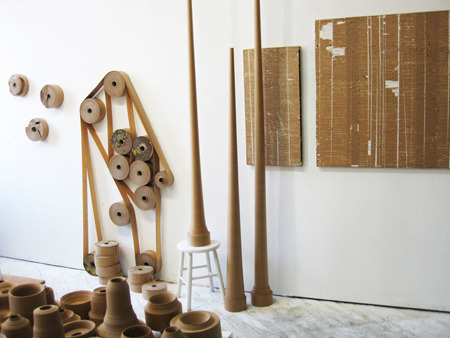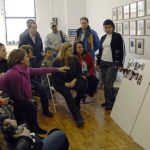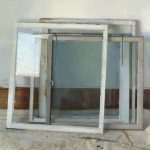The Business of Art: An Interview with Manhee Bak
SS: The first time I saw your work was at your solo show at John Jay College last year. Can you speak a bit about these pieces and what they’re made of? I found them so beautiful; they almost reminded me of ceramics, as if you were working on a pottery wheel and the sides or the walls of clay were rising.
MB: The materials are always interesting to me. Some of them are random; some of them are new, which is perfect for me. Part of the reason I ended up in set design was I was dealing with a lot of materials. I was always interested in materials, particularly industrial and construction materials. This particular material was near me for years but I just wasn’t paying attention to it. It was in boxes in the hallway of my space, just stacked there. One day I picked up one of them and thought about what I could do with it. It was so nice; I particularly liked the raw color. I was pushing and playing with it; manipulating this thing. I didn’t want to manipulate too much—I wanted to respect the material as it is, not destroy the beauty of it and yet bring to something that’s new. At some point I thought, let’s make some ceramics—paper ceramics. And then I could develop it more and more, going bigger and pushing it so it became really tall. I could push up and make a complete set-up, like a cave with icicles. Then later, I found out that the paper was packing tape.
SS: Oh, it’s packing tape! I was going to ask you what it was.
MB: Yeah, it’s called gummed packing tape. It comes in a roll. For me it’s a very fun piece.
SS: Yeah it seems very fun, like you’re playing.
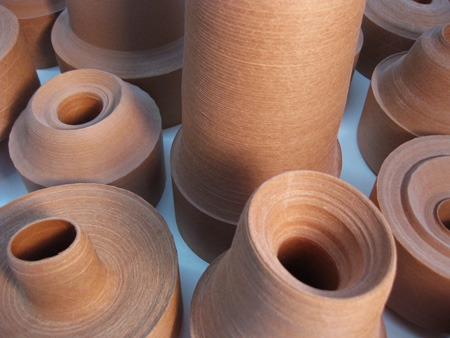
MB: A number of people thought that I was dealing with a lot of political issues. It was torturing me. I liked it in a way but I had to constantly think about what’s pushing me to think in a certain way. And really, there’s not much thinking involved. I just come here and it’s a dialogue between me and the materials.
SS: What’s a typical day like in your studio? Do you come in and not have a sense of what you want to do? Is it a surprise, or do you feel like there are specific tasks that you want to accomplish?
MB: No—I just sit in here and think a lot about the work. I almost never just jump in. Even if I don’t do anything in my studio, sitting here is a bit like meditating; I can think more clearly. Even if I don’t do any work, it helps for the following day or the next time I come in and do something. When I’m at home I’m completely disengaged from the work. Circumstance makes all the difference. So when I come here, my work is mostly about installing and drawing things. I do a lot of drawings but only a handful of them come out working. In any case, it’s great to record, to sketch things. Eventually it helps me. I’ve always liked the raw, in-process quality of drawing.
SS: Are these more recent? [Pointing to the wall.]
MB: Yeah. These drawings are made by picking up dust from the floor—
SS: Oh my gosh. You took the Scotch tape and pulled up the dust from the floor?
MB: Yeah, but I have to use nice, strong spray glue. Because when you pick it up…
SS: Then it no longer sticks so you have to glue the tape to the paper.
MB: Yeah and then I lay it out here and spray glue and it sticks fine. And also the sheen of the tape reflects from the side, which is nice on the matte paper.

SS: That’s a great idea—and it’s a good way to keep your studio clean, too.
MB: Yeah, I know it. When I do a show I actually use the dust from that building. Last year I did one in upstate New York, in a nice old building. I picked the dust off the stairway and just put it on there. It’s not that I’m enjoying this work; it’s that I’m enjoying what I’m doing when I’m doing it. Sometimes I collect dust from different places and bring it together. This one is about a house, and blueprints. I want to build—I like that blueprint quality.
SS: The oversize paper is like a blueprint. And it’s such an unexpected material, the humbleness of packing tape or the dirt under our feet or the things people wouldn’t think of as being beautiful or aesthetically pleasing, you’re elevating to a higher plane.
MB: I’m not trying to convince people that I’m using very unique materials. They’re ordinary. Although I haven’t seen anyone using them, that aspect is not very important to me. I’m sure that somebody uses tape a different way but it’s more that I always try to come up with something that speaks to me. This looks like concrete, right? [Pointing to a sculpture on a table]
SS: Yes, but is it painted Styrofoam?
MB: It is. I didn’t use any decorative spray paint to make this texture. It’s just regular spray and when I sprayed the Syrofoam the material broke down. I’ve been doing a lot of work with interiors; I know how to deal with space, not just the material—the space helps me to see. After working at my job I became much more comfortable with space.
SS: So what was your job—doing interior work on buildings like drywall or…?
MB: MB: Yeah, woodwork, drywall and painting interiors. I can’t imagine now going back to doing canvas work— there’s no way. I can’t do that. It’s not because I don’t like it; there’s no freedom to explore. For me, freedom is the most important thing.
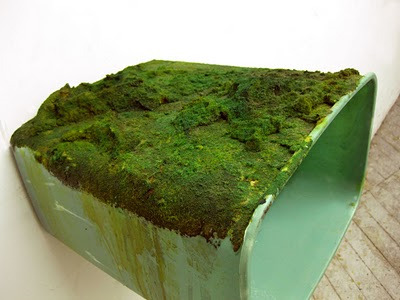
SS: When you’re painting on a canvas, there’s no investigation of new materials for you. A lot of what you’re doing is playing around, referencing what one does in childhood. Were you encouraged to make art as a child, or does your work have nothing to do with that time for you?
MB: Yes, much of what I do has to do with my childhood. I became committed to being an artist when I was really young, beginning in elementary school. In High School, I had a studio all to myself and sometimes I stayed there more than at home.
SS: Yeah. And are you familiar with contemporary Korean artists? Or when you were living in Korea 17 years ago, were you more in touch with the American artists and that’s what made you want to come here?
MB: At that time it wasn’t like Korea today. When I was growing up, I would look at books about contemporary artists from the U.S. and Europe and in many ways it was different from Korean art, for sure. Nowadays everything is changed again. A lot of artists from here have shows there, and it’s easy in any place to see, say, Damien Hirst’s work. It’s globalized. It wasn’t like that when I was growing up in Korea. Now I like to see contemporary Korean work, and there are some good Korean artists showing in big galleries in the U.S.
SS: So do you feel like there’s more opportunities for Korean artists now than there were when you left to come to the U.S.?
MB: Absolutely. For example, I can have a bigger studio there, and there are better opportunities to show there. The world is seeing Korea today. Korea is not uncompetitive but it’s less competitive than here. And I do know many gallery owners and many of my very close friends there are established and successful artists.
Manhee Bak is a visual artist born in South Korea who came to New York City in 1994. He received his M.F.A. from The City College of the City University of New York in 1999. He currently lives and works in Long Island City, NY, with his wife and son.

